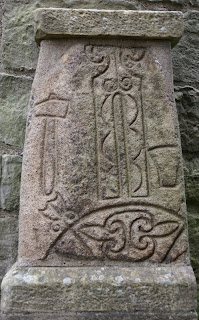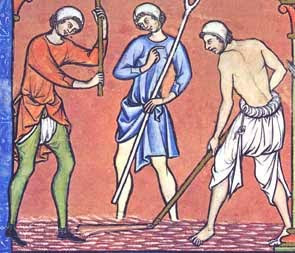Going Historical...2
Continuing on from yesterday's Part One of GOING HISTORICAL...
 Historian Robin Flemming recently gave a talk at Harvard on how the economic calamity in early medieval Britain of fifth century led to the "reduce, reuse, recycle" of Roman ruins. Thrown into abject poverty by the withdrawal of the Romans, recycling was a way of survival. "Without the unifying force of the state, its culture, transportation system, and manufacturing prowess," said Fleming, "Britain was plunged into centuries of economic travail. With no money, no industry, and no legacy of craft, there was no one left to quarry stone, smelt metals, or make pottery. Britain was 'a-ceramic' for the next 600 years." But there was at least plenty to recycle: Roman-era towns, manufacturing sites, forts, villas, and temple complexes were raided for quarried stone, iron clamps, and hefty nails. Lead pipes were stripped from deftly engineered water systems and graves robbed for pottery and cooking utensils.
Historian Robin Flemming recently gave a talk at Harvard on how the economic calamity in early medieval Britain of fifth century led to the "reduce, reuse, recycle" of Roman ruins. Thrown into abject poverty by the withdrawal of the Romans, recycling was a way of survival. "Without the unifying force of the state, its culture, transportation system, and manufacturing prowess," said Fleming, "Britain was plunged into centuries of economic travail. With no money, no industry, and no legacy of craft, there was no one left to quarry stone, smelt metals, or make pottery. Britain was 'a-ceramic' for the next 600 years." But there was at least plenty to recycle: Roman-era towns, manufacturing sites, forts, villas, and temple complexes were raided for quarried stone, iron clamps, and hefty nails. Lead pipes were stripped from deftly engineered water systems and graves robbed for pottery and cooking utensils.
 In the summer of 2002, I ran around Aberdeenshire and Angusshire chasing all things Pictish: stones, history, castles, ruins, and even took rubbings. The Picts were a warlike Celtic people living in Scotland from before the Roman invasion of Britain through the Early Middle Ages. In language, society, and culture, they were distinct from all the other Celtic tribes of the United Kingdom. A ne study has now discovered that the Picts had a distinct writing language to support their spoken tongue. What were previously thought of as only significant symbols is now said to be a part of an elaborate writing system.
In the summer of 2002, I ran around Aberdeenshire and Angusshire chasing all things Pictish: stones, history, castles, ruins, and even took rubbings. The Picts were a warlike Celtic people living in Scotland from before the Roman invasion of Britain through the Early Middle Ages. In language, society, and culture, they were distinct from all the other Celtic tribes of the United Kingdom. A ne study has now discovered that the Picts had a distinct writing language to support their spoken tongue. What were previously thought of as only significant symbols is now said to be a part of an elaborate writing system.
 "Following the major international success of the first Writing England conference two years ago, the University of Leicester School of English is about to hold a second conference in the series, which will take a wider view of the book cultures in the Middle Ages and the ideas and research interests they have inspired." The university also hosts The English Manuscript Project, which examines all manuscripts containing English and written in England between 1060 and 1220.
"Following the major international success of the first Writing England conference two years ago, the University of Leicester School of English is about to hold a second conference in the series, which will take a wider view of the book cultures in the Middle Ages and the ideas and research interests they have inspired." The university also hosts The English Manuscript Project, which examines all manuscripts containing English and written in England between 1060 and 1220.
 Y'all! There's a whole entire conference devoted to exposing the hidden history of underwear in the Middle Ages. Called Underpinnings: The Evolution of Underwear from the Middle Ages through Early Modernity, the conference was on April 24, 2010 at Binghampton University. "Few [historians], however, have given thought to what lies beneath, which, even while having a functional role, comprises a system of sartorial signs that tell much with respect to social mores and shifting views of the body."
Y'all! There's a whole entire conference devoted to exposing the hidden history of underwear in the Middle Ages. Called Underpinnings: The Evolution of Underwear from the Middle Ages through Early Modernity, the conference was on April 24, 2010 at Binghampton University. "Few [historians], however, have given thought to what lies beneath, which, even while having a functional role, comprises a system of sartorial signs that tell much with respect to social mores and shifting views of the body."
 The Peerage is a genealogical survey of the peerage of Britain as well as the royal families of Europe by Darryl Lundy of Ngaio, Wellington, New Zealand.
The Peerage is a genealogical survey of the peerage of Britain as well as the royal families of Europe by Darryl Lundy of Ngaio, Wellington, New Zealand.
 Going much further back in history, to 40,000 years ago and a hitherto unknown migration out of Africa to Sibera, a new human species is in the process of being identified based solely on a child's pinky finger. This homonid called X-Woman, though in fossilized actuality is a child between 5 and 7 years old, is said to have left Africa 1 million years ago. The remains were found in Denisova Cave in the Altay Mountains of southern Siberia.
Going much further back in history, to 40,000 years ago and a hitherto unknown migration out of Africa to Sibera, a new human species is in the process of being identified based solely on a child's pinky finger. This homonid called X-Woman, though in fossilized actuality is a child between 5 and 7 years old, is said to have left Africa 1 million years ago. The remains were found in Denisova Cave in the Altay Mountains of southern Siberia.


0 comments:
Post a Comment